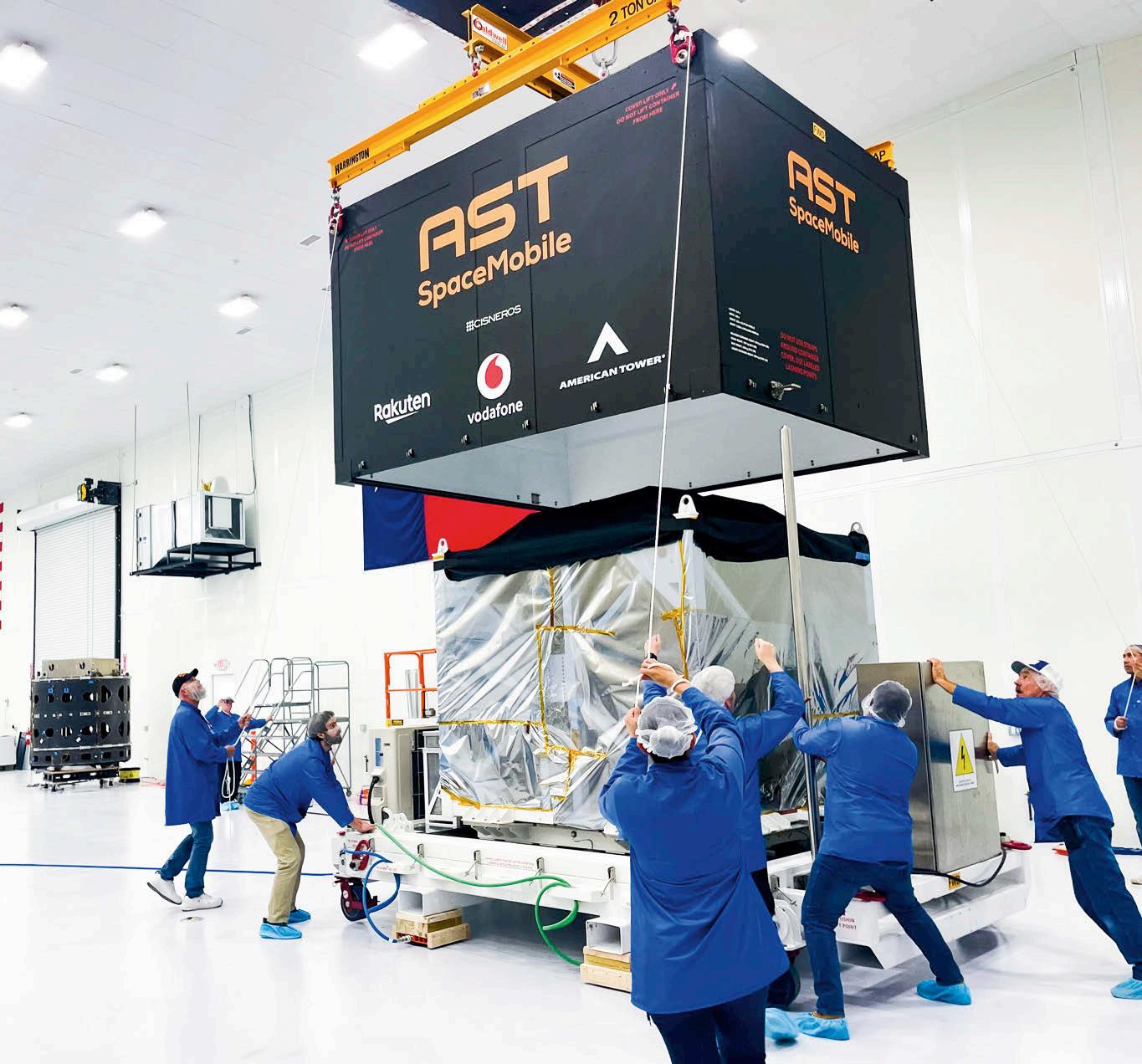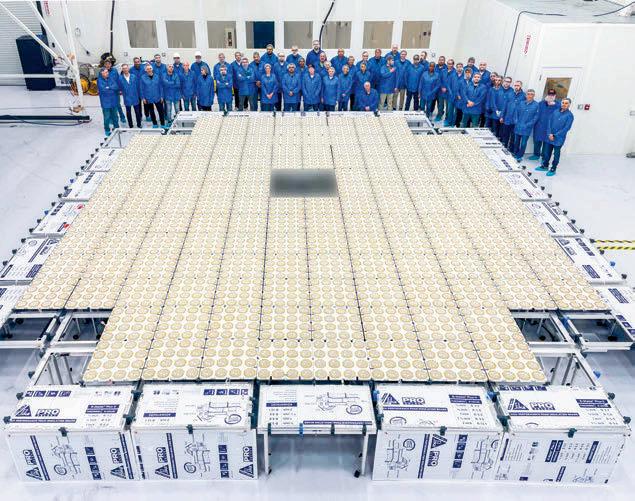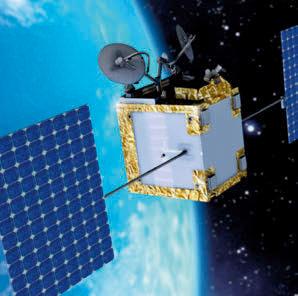
5 minute read
SPACE TO MOBILE
from UK5G. Issue 11
A quarter of a century ago, Motorola launched Iridium, the first satellite-based mobile network. It flopped. Killed by cellular. Now space is back. Andrew Orlowski looks at how low earth orbit satellites can reach the parts towers cannot.
REGULATORS LIKE TO put a cap on how tall mobile phone towers can be around the world, but an audacious space venture is about to smash such limits. A rocket will roar into the sky above Cape Canaveral later this month. After reaching an altitude of around 500km above Earth, it releases its payload: the satellite BlueWalker 3, which then turns into a mobile phone base station.
Advertisement
In many ways, this is the most ambitious satellite venture yet attempted, one that many experts thought impossible: an orbiting cellular mobile network. It’s the first and only such network in space that unmodified, everyday mobile phones and modems can use. This is a collaboration between AST Space Mobile and Vodafone, and the motivation for Vodafone is bringing what’s called direct-to-mobile coverage next year for regions not covered by a signal. Vodafone has a significant presence in Africa and India, and in many regions users with cheap commodity smartphones attach to these new Vodafone “masts”, joining the network automatically, initially with 4G, but later with 5G.
To achieve this feat requires satellites several times bigger and many times more complex than NASA’s $10billion James Webb Telescope. And there will be 20 of them to start with. The mind-boggling ambition of the venture is an example of the explosion of investment in space communications, says Paul Febvre, Chief Technology Officer at the
UK’s Satellite Applications Catapult.
Sixty years ago, the space market opened up to the private sector with Telstar – the first private satellite network – an event that captured the imagination so much at the time that it inspired a rare No 1 pop smash on both sides of the Atlantic.
“This is a renaissance, but satellite communication has always had to stand on its own two feet,” says Febvre. “The first consumer market was broadcast media, however increasingly enterprise and consumer demand for broadband communications is driving investment at scale.”
Two economic trends have formed a confluence – and just as when two rivers merge, things can get quite turbulent. One trend is the diminishing cost of throwing communications gear into space, thanks to reusable and cheaper private sector rocketry. The best known is Elon Musk’s SpaceX and its internet satellite subsidiary, Starlink.
Rockets Are Cheap
Musk has launched thousands of small satellites into Low Earth Orbit: LEO satellites. But at the same time, the costs of running terrestrial mobile networks have stayed stubbornly high. There’s no respite for landlocked mobile operators who must churn their equipment every few years, making constant capital expenditure (capex) top-ups, and the operating costs (opex) are increasing.
“The investment requirements of terrestrial mobile networks are sky wateringly high,” says Febvre. “That’s what’s causing this re-visiting of how we deliver communications.” While the vast outlays of the 3G auction haven’t been repeated, licence costs remain a significant outlay for mobile operators. Every five years or so the network must be refreshed. And the power requirements of the equipment have rocketed with 5G. In 2019, China Mobile shed some light on this. 5G needs three times as many base stations as 4G, each base station requires three times the energy – and is four times the price. And that’s before expensive and power-guzzling “edge compute” functions have been added. Even as they consolidate and re-design their networks to gain efficiency, mobile operators are running to keep still.
The mobile satellites in space have several advantages. They use virgin infrastructure, without the slow backhaul links that make the 5G experience so miserable for consumers. Despite being very far away, which increases round trip delays or latencies, what the engineers call the “link budget” is low. These electrons don’t need to trundle across ancient copper and through old switching equipment. While Starlink or AST won’t be quite as zippy as a pure virgin 5G network served only by fibre, they offer a reasonable consumer experience. And they’ve proved unexpectedly resilient too, particularly in Ukraine. SpaceX sent 15,000 Starlink kits to the country in March, and it has evaded Russia’s attempts to block and jam the signals.
“It helped us a lot, in many moments related to the blockade of our cities, towns, and related to the occupied territory,” Ukraine President Volodymyr Zelensky acknowledged in June. “Sometimes we completely lost communication with those places.” Starlink satellites have been used operationally to drone strikes, and to inform populations under siege. However, it’s primarily in data and voice communications where the race to populate space will see the greatest market impact.
Four Tennis Courts
Back in Newbury, Vodafone executives have been monitoring the pre-flight checks to BlueWalker 3 with AST Space Mobile, which is a scaled-down version of the operational satellites. “It’s fair to call it an audacious engineering feat,” says Luke Ibbetson, head of Vodafone’s R&D organisation. He’s also a director at AST Space Mobile.
While the thousands of new low Earth orbit satellites are the size of an old Mini, the Vodafone network stations will be much larger. BlueWalker 3 is the size of a tennis court, which means it already dwarves the $10billion James Webb Telescope. The operational satellites will be four times as large again, at 900 square metres. “They’re approaching the largest thing mankind has put in orbit,” says Ibbetson.

The two partners began collaborating in 2018, with Vodafone investing in the Midland, Texas-based company and helping redefine the design. Unfurling the vast solar-powered base station is both complex and risky. But it’s remarkable that it’s even got this far. Radio boffins declared that terrestrial cellular equipment would never be practical in orbit –for reasons AST says it has overcome.
The reason for the scepticism is a phenomenon known as the Doppler effect, which is the variation in wave frequency created by a moving object. In 1845, the Austrian physicist after whom the phenomenon is named, CJ Doppler, placed trumpeters in a railway carriage, while musically trained listeners lined the track, and noted the sound as it passed. A mobile phone experiences the same effect when the base station is moving – in this case, at thousands of miles an hour. On its own, this would indeed defeat the terrestrial equipment we use today. AST’s research emerged from science that investigates how to mitigate for the Doppler effect of a fast-moving base transmitter and receiver. AST has more than 2,000 patents, and many deal with just this.
“The special sauce that AST has introduced is a way of compensating for the increased Doppler,” Ibbetson explains. “We’ve been able to test that and we’ve tested them in the lab using real equipment.
We’ve got a large amount of confidence. In addition, the scaled-down version has been laid out in reverse, too: we’ve tested the array that’s going into space on the ground, and put a mobile phone in space to talk to it.”
What is surprising is the performance of the new low Earth orbit systems. Since the 1990s internet has used geostationary satellites, at altitudes far higher than the new arrivals, that made for long delays.
“It doesn’t suffer as much latency as you get from a geostationary satellite,” Ibbetson explains. “It means end-to-end we can reduce it to something very favourable, and we don’t have several levels of aggregation, as we do on a terrestrial network.”
“Each satellite is a large beam-forming array. So all of the stuff that compensates for the larger link budget is done through space by having a physically larger antenna array.”

The AST satellites will provide coverage to plus or minus 8 degrees on either side of the equator, a territory covering the tip of India, Indonesia and of course, Venezuela and Columbia, and vast swathes of equatorial Africa. It will become operational in 2023.










